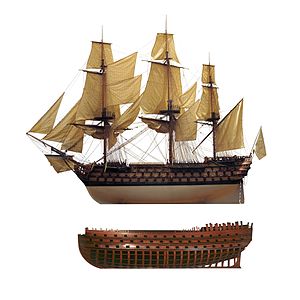Océan type 118-gun ship of the line

1/48 scale model of the Océan class 120-gun ship of the line Commerce de Marseille, on display at Marseille naval museum; and Half-hull of a 120-gun ship of the line on display at Brest naval museum.
|
|
| Class overview | |
|---|---|
| Name: | Océan |
| Builders: | Plans by Jacques-Noël Sané |
| Operators: |
|
| Preceded by: | Bretagne |
| Succeeded by: | Commerce de Paris class |
| Subclasses: | Souverain class |
| In commission: | 1788–1882 |
| Completed: | 16 |
| General characteristics | |
| Type: | Ship of the line |
| Displacement: |
5,098 tonnes (before conversion to steam), Ville de Paris in 1858: 5,302 tonnes |
| Tons burthen: | 2,746 tonnes |
| Length: |
65.18 metres (196.6 French feet), Ville de Paris in 1858: 69.05 meters |
| Beam: | 16.24 metres (50 French feet) |
| Draught: | 8.12 metres (25 French feet) |
| Propulsion: | sail, 3,265 m² |
| Speed: | 10 knots |
| Complement: | 1,079–1,130 men |
| Armament: |
|
| Armour: | Timber |
| Notes: | Ships in class include: Commerce de Marseille, Océan, Orient, Majestueux, Impérial, Austerlitz, Wagram, Royal-Louis, Montebello, Héros, Souverain, Trocadéro, Friedland, Ville-de-Paris, Louis-XIV, Roi-de-Rome (never launched) |
5,098 tonnes (before conversion to steam),
65.18 metres (196.6 French feet),
The Océan-class ships of the line were a series of 16 first-rate 118-gun ships of the line of the French Navy, designed by engineer Jacques-Noël Sané. Fifteen were completed from 1788 on, with the last one entering service in 1854. The first of the series was the Commerce de Marseille.
The 5,100 ton 118-gun type was the largest type of ship built up to then, besting the Spanish ship Santísima Trinidad. Up to 1790 Great Britain, the largest of the battle fleet nations, had not built especially large battleships because the need for large numbers of ships had influenced its battleship policy. The French initiated a new phase in battleship competition when they laid down a large number of three-deckers of around 5,000 tons.
Along with the 74-gun of the Téméraire type and the 80-gun of the Tonnant type, the Océan 120-gun type was to become one of the three French standard types of battleships during the war period 1793 to 1815.
These were the most powerful ships of the Napoleonic Wars and a total of ten served during that time. These ships, however, were quite expensive in terms of building materials, artillery and manpower and so were reserved for admirals as their fleet flagships.
Some of the ships spent 40 years on the stocks and were still in service in 1860, three of them having been equipped with auxiliary steam engines in the 1850s.
The design for the first 118-gun three-decker warships originated in 1782 with a design prepared by the shipwright Antoine Groignard. Carrying an extra pair of cannon on each deck (including the quarterdeck), this raised the firepower of these capital ships from 110 to 118 guns, including an unprecedented thirty-two 36-pounder guns in the lowest tier. The French Navy ordered two of these, to be built at Toulon and at Brest, the shipwright entrusted with the construction of the latter ship being Jacques-Noël Sané. However, with the onset of peace following the conclusion of the American War of Independence, these two ships were cancelled in 1783, along with several others. The concept was revived in 1785 when Sané, in conjunction with Jean-Charles de Borda, developed the design of the Commerce de Marseille, marking a leap in the evolution of ship of the line design, when the first two ships were re-ordered at Toulon and Brest. The hull was simple with straight horizontal lines, minimal ornaments, and tumblehome. The poop deck was almost integral the gunwale, and the forecastle was minimal.
...
Wikipedia
